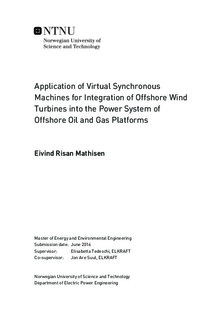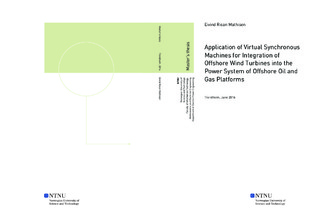| dc.contributor.advisor | Tedeschi, Elisabetta | |
| dc.contributor.advisor | Suul, Jon Are | |
| dc.contributor.author | Mathisen, Eivind Risan | |
| dc.date.accessioned | 2016-09-14T14:00:19Z | |
| dc.date.available | 2016-09-14T14:00:19Z | |
| dc.date.created | 2016-06-09 | |
| dc.date.issued | 2016 | |
| dc.identifier | ntnudaim:15158 | |
| dc.identifier.uri | http://hdl.handle.net/11250/2407273 | |
| dc.description.abstract | This thesis addresses the technology known as "Virtual Synchronous Machines" and studies an application where it is used to integrate offshore wind turbines into the power systems of oil and gas platforms. The virtual synchronous machine is a technology which involves the controlling of an electric power converter in order to mimic the properties of a traditional synchronous machine. This thesis studies a fictional system where the virtual synchronous machine control strategy is applied to a voltage source converter which connects a battery bank to the power system of an offshore oil and gas platform. A wind turbine is also connected to the same platform.
A model of this system has been constructed and implemented into a simulation program. A lot if work went into experimenting and exploring the capabilities of this model. This process enabled the identification of several relevant test cases to simulate and present.
This thesis presents the results of several test cases that involve events such as rapid increase in electrical load and variations in the wind power from the turbine. The focus is on the control strategies of the various components, how they interact with each other and how they effect the power grid of the platform.
The simulations show that a battery bank that is controlled by a virtual synchronous machine is able run in parallel with a traditional synchronous generator and a wind turbine and they demonstrate how these components distribute the electrical load between themselves. The simulations also demonstrate how the battery bank and a wind turbine are able operate in island mode where the controls of the battery bank is controlling the frequency of the electrical grid. These controls also respond to changes in load, which means the gas turbine can be turned of when there is enough wind power available. Overall these simulations indicate that this virtual synchronous machine implementation has a practical suitability when it comes to the connection of offshore wind power to oil and gas platforms. | |
| dc.language | eng | |
| dc.publisher | NTNU | |
| dc.subject | Energi og miljø, Elektriske kraftsystemer | |
| dc.title | Application of Virtual Synchronous Machines for Integration of Offshore Wind Turbines into the Power System of Offshore Oil and Gas Platforms | |
| dc.type | Master thesis | |
| dc.source.pagenumber | 77 | |

